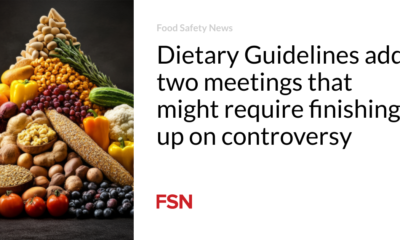Food
The 2025 edition of Dietary Guidelines for Americans is nearing the finish line

Deadlines for another important government function related to food are approaching.
The 2025 Dietary Guidelines for Americans are in development to provide guidance on what to eat and drink to build a healthy diet that can promote healthy growth and development, help prevent diet-related chronic diseases, and meet nutritional needs can meet.
The expert Dietary Guidelines Advisory Committee, whose members were appointed in early 2023, has met five times, with only one more meeting possible on September 25-26, 2024 if necessary. If a sixth meeting takes place, registration details will be made public close to the meeting date.
The committee consists of 20 nationally recognized experts in the field of food and nutrition.
Since 1990, the Secretaries of Agriculture and Health and Human Services have been required by law to publish the Dietary Guidelines for Americans every five years. The recommendations of the expert committee should be submitted to the secretaries who will make the final decisions. The Dietary Guidelines then became the cornerstone of the federal food and nutrition guidelines.
“The nature of nutritional guidance, providing advice on foods and nutrients that you can eat more or less of, has remained relatively consistent,” the government said. “However, some of the specific messages have changed as nutritional science has progressed and the methods used to assess the science have advanced.”
The five-year update of the dietary guidelines is now coming to an end and has been a scientifically rigorous process spanning several years.
The U.S. Departments of Health and Human Services (HHS) and Agriculture (USDA), with input from federal experts and the public, identified proposed scientific questions and subsequently obtained the Dietary Guidelines Advisory Committee’s review.
It was up to the committee members to refine and prioritize the questions, work together to develop protocols describing how they plan to review the science, review and synthesize the evidence based on their protocols, present and consider public comments.
The committee’s work culminates in a comprehensive scientific report on the current state of nutritional science and provides independent recommendations to HHS and USDA.
Upon the presentation of the report to the Secretaries or when the two-year charter expires, whichever occurs first, the committee’s activities will end and the departments will develop the next edition of the Dietary Guidelines, based on the work of the committee, existing evidence-based federal guidelines, input from federal agencies, and public comments.
The committee examined the evidence using three approaches: data analysis, food pattern modeling and systematic reviews. Each approach has its own rigorous, protocol-driven methodology and plays a unique, complementary role in exploring the science. For each approach, HHS and USDA staff supported the committee’s review of the evidence.
This year’s update to the Guidelines has not yet caused much controversy.
According to the National Institutes of Health, the committee examined the fact that approximately 36 percent of people in the US are lactose intolerant.
The potato industry previously raised concerns about the future of potatoes in this year’s and future Dietary Guidelines for Americans. But Agriculture Secretary Tom Vilsack and Health and Human Services Secretary Xavier Becerra sent a letter to Sen. Susan Collins, R-Maine, assuring her that there is no intention or effort underway to reclassify potatoes as a grain under the guidelines.
The USDA and HHS are jointly responsible for updating the guidelines.
“The Dietary Guidelines for Americans are a framework for healthy eating, not a one-size-fits-all mold that everyone must fit into,” the letter said. “The American population is diverse, which is reflected in what and how we eat. “
While HHS and USDA acknowledge that most Americans are not following the guidelines, the U.S. wine industry is concerned about following World Health Organization guidelines. U.S. dietary guidelines say men can safely drink two drinks a day, and women one. Canada’s dietary guidelines recommend no more than two drinks per week, with polls showing 66 per cent of people aged 21 to 39 saying they would cut back.
The current ninth edition of the Dietary Guidelines for Americans (DGA) is for 2020-25. For the first time, it contains nutritional guidelines for children from birth to 23 months.
At the end of the last five years, HHS and USDA rejected the advice of the last expert panel, which recommended that the guidelines set new lower targets for sugar and alcoholic beverage consumption.
Earlier this year, the German Nutrition Association (DGE) released new dietary guidelines for Germany, which focus more on plant-based foods and emphasize health and sustainability.
The German dietary guidelines require a diet that consists of 75 percent plants and 25 percent animals. The guidelines also recommend vegetable fats such as vegetable oils over animal sources such as butter.
(Click here to sign up for a free subscription to Food Safety News.)













